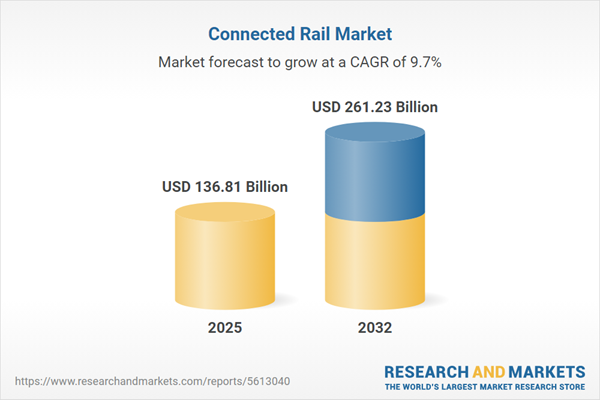Speak directly to the analyst to clarify any post sales queries you may have.
The connected rail market is evolving as rail operators prioritize digital transformation, automation, and future-ready infrastructure. Senior executives require actionable intelligence to align modernization efforts, maximize investment value, and reinforce operational resilience in a competitive environment.
Market Snapshot: Connected Rail Market Trends and Growth
The connected rail market is gaining momentum with widespread adoption of digital platforms across freight and passenger operations. Rail operators are leveraging real-time analytics, advanced communication networks, and remote monitoring to improve efficiency, safety, and responsiveness. This integration is transforming asset management and operations, enabling more agile, adaptive rail networks globally. Competitive logistics and enhanced passenger experiences are realized as organizations embrace technology-driven change. Digital transformation has become essential to meet shifting mobility demands and ensure streamlined, responsive rail service worldwide.
Scope & Segmentation in the Connected Rail Market
- Component: Hardware—including smart sensors, advanced signaling, network devices, and robust communications infrastructure—forms the foundation of digital rail environments. Software solutions for analytics, predictive monitoring, and centralized management provide operators with enhanced visibility, risk mitigation, and decision support. Services such as system integration, technical assistance, and deployment support underpin continuous performance and long-term improvements.
- Application: Asset tracking improves transparency and regulatory compliance for equipment and cargo. Energy optimization helps railways meet sustainability goals while reducing operational costs. Passenger information systems enhance the traveler experience through real-time updates and improved satisfaction. Predictive maintenance extends the lifespan of assets and boosts reliability, and security solutions address both traditional and emerging digital threats across rail networks.
- Service Type: Technical support maintains high system availability and ensures responsive troubleshooting. Operations management maximizes efficiency and asset use throughout rail infrastructure. Consulting services align digital strategies with regulatory expectations and help organizations unlock greater value from technological innovation and process modernization.
- Communication Technology: Wired and wireless options, including Bluetooth, LTE, Wi-Fi, satellite, and 5G cellular, are crucial for mission-critical communication, supporting seamless rail network operation and scalability across varied organizational and geographic landscapes.
- Region: The market spans the Americas, Europe, the Middle East and Africa, and Asia-Pacific, with notable modernization seen in China, India, Japan, Australia, Southeast Asia, and South Korea due to infrastructure investment, regulatory reforms, and rapid digitalization.
- Leading Companies Covered: Cisco Systems, Nokia, Huawei, Siemens Mobility, Alstom, Thales, Hitachi Rail, CAF, Stadler Rail, and Robert Bosch GmbH shape global innovation. Their expertise drives intelligent rail system development, network infrastructure expansions, and advanced cybersecurity deployments that define industry benchmarks.
Key Takeaways for Senior Decision-Makers
- Greater deployment of IoT and artificial intelligence supports resilient, adaptive rail networks, facilitating faster response to service disruptions and changing operational requirements.
- Investment strategies now align more closely with evolving regulations and accelerate digitalization, prioritizing sustainability across modernization initiatives.
- Edge computing paired with advanced connectivity enables real-time visibility and monitoring of rail assets, leading to improved operational decision-making and resource allocation.
- Collaboration among technology providers, infrastructure managers, and policy makers is essential for rapid digital solution rollout and early realization of operational benefits.
- Unified digital ecosystems increase control and adaptability over rail assets, optimizing security and responsiveness under shifting market dynamics.
- Cybersecurity and resilient communication systems are central to maintaining reliable operations as digital adoption expands across the rail sector.
Tariff Impact & Supply Chain Realignment
Forthcoming tariff adjustments in the United States, expected in 2025, are driving rail technology providers to diversify sourcing and manufacturing strategies. Emphasis on regional and nearshore production, combined with modular system design, is helping organizations strengthen supply chain resilience and manage risks. These shifts are intended to reduce vulnerability to trade disruptions and support enduring industry stability during ongoing realignment.
Methodology & Data Sources
This report’s findings result from comprehensive secondary research, direct interviews with industry specialists, and consistent data triangulation. The rigorous methodology ensures reliable, validated insights that meet the planning and procurement needs of senior decision-makers.
Why This Connected Rail Market Report Matters
- Provides strategic insights to support modernization, investment, and compliance within the connected rail landscape, enabling executives to address emerging challenges and mitigate risk.
- Offers detailed segmentation and deep analysis for customized investment and operational strategies across diverse rail network requirements.
- Facilitates strategic partnerships and technology adoption, supporting uninterrupted operations and adaptability as the sector continues to evolve.
Conclusion
Connected rail markets are being shaped by technological innovation, regulatory shifts, and collaborative initiatives. This report supports senior executives in making informed, agile decisions as they navigate modernization and digital transformation in rail.
Additional Product Information:
- Purchase of this report includes 1 year online access with quarterly updates.
- This report can be updated on request. Please contact our Customer Experience team using the Ask a Question widget on our website.
Table of Contents
3. Executive Summary
4. Market Overview
7. Cumulative Impact of Artificial Intelligence 2025
Companies Mentioned
The companies profiled in this Connected Rail market report include:- Cisco Systems, Inc.
- Nokia Corporation
- Huawei Technologies Co., Ltd.
- Siemens Mobility GmbH
- Alstom SA
- Thales SA
- Hitachi Rail Ltd
- Construcciones y Auxiliar de Ferrocarriles, S.A.
- Stadler Rail AG
- Robert Bosch GmbH
Table Information
| Report Attribute | Details |
|---|---|
| No. of Pages | 190 |
| Published | November 2025 |
| Forecast Period | 2025 - 2032 |
| Estimated Market Value ( USD | $ 136.81 Billion |
| Forecasted Market Value ( USD | $ 261.23 Billion |
| Compound Annual Growth Rate | 9.6% |
| Regions Covered | Global |
| No. of Companies Mentioned | 11 |









